Highly Selective Oxygen/Nitrogen Separation Membrane Engineered Using a Porphyrin-Based Oxygen Carrier
Abstract
:1. Introduction
2. Materials and Methods
2.1. Materials
2.2. Synthesis of Cobalt Porphyrin
2.3. Membrane Preparation
2.4. Characterization Methods
2.5. Molecular Modeling
3. Results and Discussion
3.1. Synthesis and Characterization of T(p-OCH3)PPCoCl
3.2. Membranes Properties and Characterizations
3.3. Molecular Modeling of O2/N2 and T(p-OCH3)PPCoCl Interactions
3.4. Gas Permeation Properties
4. Conclusions
Author Contributions
Funding
Conflicts of Interest
Abbreviations
| Pebax | poly(amide-12-b-ethylene oxide) |
| T(p-OCH3)PPCoCl | tetra(p-methoxylphenyl)porphyrin cobalt chloride |
| PVDF | polyvinylidene fluoride |
| TFC | thin film composite |
| CoPc | cobalt phthalocyanine |
| CoFPP | meso-tetrakis(pentafluorophenyl)porpyrinatocobalt |
| CoTPP | meso-tetraphenylporphyrinatocobalt |
| T(p-OCH3)PP | tetra(p-methoxylphenyl)porphyrin |
| MMMs | mixed matrix membranes |
| MgPc | magnesium phathalocyanine |
| PEI | polyetherimide |
| PU | polyurethane |
| SiO2–PVP–salcomine | SiO2–poly(N-vinylpyrrolidone)–(N,N-disalicylideneethylenediaminato)cobalt |
| [P66614]2[Co(salen)(N-mGly)(Tf2N)] | [trihexyl(tetradecyl)phosphonium]2[N,N-bis(salicylidene)ethylenediamine cobalt(N-methylglycinate)(bis(trifluoromethanesulfonyl)imid)] |
| [P66614]2[Co(salen)(N-mGly)2] | [trihexyl(tetradecyl)phosphonium]2[N,N-bis(salicylidene)ethylenediamine cobalt(N-methylglycinate)2] |
| EC | ethyl cellulose |
| CoT(2-Cl)PP | cobalt(II) meso-tetrakis(2-chlorophenyl) porphyrin |
| Im | imidazole |
| OIm | poly[(octyl methacrylate)-co-vinylimidazole] |
| CoTAP | cobalt tetra-tert-butyltetraazaporphyrin |
| CoPac | 5-(4-benzylacetoacetate)-10, 15, 20-triphenylcobaltporphyrin |
| PTA | pentaerythritol tetraacrylate |
References
- Cardona, C.A.; Amell, A.A. Laminar burning velocity and interchangeability analysis of biogas/C3H8/H2 with normal and oxygen-enriched air. Int. J. Hydrogen Energy 2013, 38, 7994–8001. [Google Scholar] [CrossRef]
- Caro, J. Oxygen-Enriched Air (OEA) Production by Membrane Reactors. In Encyclopedia of Membranes; Drioli, E., Giorno, L., Eds.; Springer: Heidelberg, Berlin, Germany, 2016; pp. 1446–1447. ISBN 978-3-662-44324-8. [Google Scholar]
- Chong, K.C.; Lai, S.O.; Lau, W.J.; Thiam, H.S.; Ismail, A.F.; Zulhairun, A.K. Fabrication and Characterization of Polysulfone Membranes Coated with Polydimethysiloxane for Oxygen Enrichment. Aerosol Air Qual. Res. 2017, 17, 2735–2742. [Google Scholar] [CrossRef]
- Hemmati-Sarapardeh, A.; Mohagheghian, E. Modeling interfacial tension and minimum miscibility pressure in paraffin-nitrogen systems: Application to gas injection processes. Fuel 2017, 205, 80–89. [Google Scholar] [CrossRef]
- Frank, M.; Drikakis, D. Draining Water from Aircraft Fuel Using Nitrogen Enriched Air. Energies 2018, 11, 908. [Google Scholar] [CrossRef]
- Wang, Y.; Yang, R.T. Chemical Liquid Deposition Modified 4A Zeolite as a Size-Selective Adsorbent for Methane Upgrading, CO2 Capture and Air Separation. ACS Sustain. Chem. Eng. 2019, 7, 3301–3308. [Google Scholar] [CrossRef]
- Belaissaoui, B.; Le Moullec, Y.; Hagi, H.; Favre, E. Energy efficiency of oxygen enriched air production technologies: Cryogeny vs membranes. Sep. Purif. Technol. 2014, 125, 142–150. [Google Scholar] [CrossRef]
- Hu, T.; Zhou, H.; Peng, H.; Jiang, H. Nitrogen Production by Efficiently Removing Oxygen From Air Using a Perovskite Hollow-Fiber Membrane With Porous Catalytic Layer. Front. Chem. 2018, 6, 329. [Google Scholar] [CrossRef] [PubMed] [Green Version]
- Chong, K.C.; Lai, S.O.; Thiam, H.S.; Teoh, H.C.; Heng, S.L. Recent progress of oxygen nitrogen separation using membrane technology. J. Eng. Sci. Technol. 2016, 11, 1016–1030. [Google Scholar]
- Wang, H.H.; Werth, S.; Schiestel, T.; Caro, A. Perovskite hollow-fiber membranes for the production of oxygen-enriched air. Angew. Chem. Int. Ed. 2005, 44, 6906–6909. [Google Scholar] [CrossRef]
- Dong, G.; Zhang, X.; Zhang, Y.; Tsuru, T. Enhanced Permeation through CO2-Stable Dual-Inorganic Composite Membranes with Tunable Nanoarchitectured Channels. ACS Sustain. Chem. Eng. 2018, 6, 8515–8524. [Google Scholar] [CrossRef]
- Robeson, L.M. The upper bound revisited. J. Membr. Sci. 2008, 320, 390–400. [Google Scholar] [CrossRef]
- Nagar, H.; Vadthya, P.; Prasad, N.S.; Sridhar, S. Air separation by facilitated transport of oxygen through a Pebax membrane incorporated with a cobalt complex. RSC Adv. 2015, 5, 76190–76201. [Google Scholar] [CrossRef]
- Kuraoka, K.; Chujo, Y.; Yazawa, T. A novel inorganic-organic hybrid membrane for oxygen/nitrogen separation containing a cobalt(II) Schiff base complex as oxygen carrier using poly(N-vinylpyrrolidone) as mediator. Chem. Commun. 2000, 24, 2477–2478. [Google Scholar] [CrossRef]
- Matsuoka, A.; Kamio, E.; Mochida, T.; Matsuyama, H. Facilitated O2 transport membrane containing Co(II)-salen complex-based ionic liquid as O2 carrier. J. Membr. Sci. 2017, 541, 393–402. [Google Scholar] [CrossRef]
- Ruaan, R.C.; Chen, S.H.; Lai, J.Y. Oxygen/nitrogen separation by polycarbonate/Co(SalPr) complex membranes. J. Membr. Sci. 1997, 135, 9–18. [Google Scholar] [CrossRef]
- Nishide, H.; Ohyanagi, M.; Okada, O.; Tsuchida, E. Highly Selective Transport of Molecular Oxygen in a Polymer Containing a Cobalt Porphyrin Complex as a Fixed Carrier. Macromolecules 1986, 19, 494–496. [Google Scholar] [CrossRef]
- Nishide, H.; Ohyanagi, M.; Okada, O.; Tsuchida, E. Dual-Mode Transport of Molecular Oxygen in a Membrane Containing a Cobalt Porphyrin Complex as a Fixed Carrier. Macromolecules 1987, 20, 417–422. [Google Scholar] [CrossRef]
- Yang, J.P.; Huang, P.C. Facilitated transport of oxygen in ethyl cellulose membranes containing cobalt porphyrins as oxygen carriers. J. Appl. Polym. Sci. 2000, 77, 484–488. [Google Scholar] [CrossRef]
- Yang, J.P.; Huang, P.C. A study of cobalt(II) porphyrins on their oxygen-binding behaviors and oxygen-facilitated transport properties in polymeric membranes. Chem. Mater. 2000, 12, 2693–2697. [Google Scholar] [CrossRef]
- Shinohara, H.; Shibata, H.; Wohrle, D.; Nishide, H. Reversible oxygen binding to the polymeric cobalt tetraazaporphyrin complex and oxygen-facilitated transport through its membrane. Macromol. Rapid Commun. 2005, 26, 467–470. [Google Scholar] [CrossRef]
- Shoji, M.; Oyaizu, K.; Nishide, H. Facilitated oxygen transport through a Nafion membrane containing cobaltporphyrin as a fixed oxygen carrier. Polymer 2008, 49, 5659–5664. [Google Scholar] [CrossRef]
- Chikushi, N.; Ohara, E.; Hisama, A.; Nishide, H. Porphyrin Network Polymers Prepared via a Click Reaction and Facilitated Oxygen Permeation Through Their Membranes. Macromol. Rapid Commun. 2014, 35, 976–980. [Google Scholar] [CrossRef] [PubMed]
- Choi, W.; Ingole, P.G.; Li, H.; Kim, J.H.; Lee, H.K.; Baek, I.H. Preparation of facilitated transport hollow fiber membrane for gas separation using cobalt tetraphenylporphyrin complex as a coating material. J. Clean. Prod. 2016, 133, 1008–1016. [Google Scholar] [CrossRef]
- Sun, Z.; She, Y.; Zhong, R. Synthesis of p-substituted tetraphenylporphyrins and corresponding ferric complexes with mixed-solvents method. Front. Chem. Eng. China 2009, 3, 457–461. [Google Scholar] [CrossRef]
- Momo, P.B.; Bellete, B.S.; Brocksom, T.J.; De Souza, R.O.M.A.; De Oliveira, K.T. Exploiting novel process windows for the synthesis of meso-substituted porphyrins under continuous flow conditions. RSC Adv. 2015, 5, 84350–84355. [Google Scholar] [CrossRef]
- Kumar, A.; Maji, S.; Dubey, P.; Abhilash, G.J.; Pandey, S.; Sarkar, S. One-pot general synthesis of metalloporphyrins. Tetrahedron Lett. 2007, 48, 7287–7290. [Google Scholar] [CrossRef]
- Bhavsar, R.S.; Mitra, T.; Adams, D.J.; Cooper, A.I.; Budd, P.M. Ultrahigh-permeance PIM-1 based thin film nanocomposite membranes on PAN supports for CO2 separation. J. Membr. Sci. 2018, 564, 878–886. [Google Scholar] [CrossRef]
- Frisch, M.J.; Trucks, G.W.; Schlegel, H.B.; Scuseria, G.E.; Robb, M.A.; Cheeseman, J.R.; Scalmani, G.; Barone, V.; Mennucci, B.; Petersson, G.A.; et al. Gaussian 09, Revision D. 01, Gaussian, Inc., Wallingford CT, 2013 Search PubMed;(b) AD Becke. J. Chem. Phys. 1993, 5648, 785–789. [Google Scholar]
- Li, G.Q.; Govind, R. Separation of Oxygen from Air Using Coordination Complexes: A Review. Ind. Eng. Chem. Res. 1994, 33, 755–783. [Google Scholar] [CrossRef]
- Chen, W.T.; El-Khouly, M.E.; Fukuzumi, S. Saddle Distortion of a Sterically Unhindered Porphyrin Ring in a Copper Porphyrin with Electron-Donating Substituents. Inorg. Chem. 2011, 50, 671–678. [Google Scholar] [CrossRef]
- De Dai, Z.; Bai, L.; Hval, K.N.; Zhang, X.P.; Zhang, S.J.; Deng, L.Y. Pebax®/TSIL blend thin film composite membranes for CO2 separation. Sci. China Chem. 2016, 59, 538–546. [Google Scholar] [CrossRef]
- Sridhar, S.; Aminabhavi, T.M.; Mayor, S.J.; Ramakrishna, M. Permeation of carbon dioxide and methane gases through novel silver-incorporated thin film composite Pebax membranes. Ind. Eng. Chem. Res. 2007, 46, 8144–8151. [Google Scholar] [CrossRef]
- Wang, H.; Liu, S.; Zhao, Y.; Wang, J.; Yu, Z. Insights into the Hydrogen Bond Interactions in Deep Eutectic Solvents Composed of Choline Chloride and Polyols. ACS Sustain. Chem. Eng. 2019, 7, 7760–7767. [Google Scholar] [CrossRef]
- Nafisi, V.; Hagg, M.B. Development of Nanocomposite Membranes Containing Modified Si Nanoparticles in PEBAX-2533 as a Block Copolymer and 6FDA-Durene Diamine as a Glassy Polymer. ACS Appl. Mater. Interfaces 2014, 6, 15643–15652. [Google Scholar] [CrossRef] [PubMed]
- Nafisi, V.; Hagg, M.B. Development of dual layer of ZIF-8/PEBAX-2533 mixed matrix membrane for CO2 capture. J. Membr. Sci. 2014, 459, 244–255. [Google Scholar] [CrossRef]
- Dong, L.; Zhang, C.; Bai, Y.; Shi, D.; Li, X.; Zhang, H.; Chen, M. High-Performance PEBA2533-Functional MMT Mixed Matrix Membrane Containing High-Speed Facilitated Transport Channels for CO2/N2 Separation. ACS Sustain. Chem. Eng. 2016, 4, 3486–3496. [Google Scholar] [CrossRef]
- Li, J.F.; Noll, B.C.; Oliver, A.G.; Scheidt, W.R. Structural Insights into Ligand Dynamics: Correlated Oxygen and Picket Motion in Oxycobalt Picket Fence Porphyrins. J. Am. Chem. Soc. 2012, 134, 10595–10606. [Google Scholar] [CrossRef] [PubMed] [Green Version]
- Shentu, B.Q.; Nishide, H. Facilitated oxygen transport membranes of picket-fence cobaltporphyrin complexed with various polymer matrixes. Ind. Eng. Chem. Res. 2003, 42, 5954–5958. [Google Scholar] [CrossRef]
- Kurdi, J.; Tremblay, A.Y. Improvement in polyetherimide gas separation membranes through the incorporation of nanostructured metal complexes. Polymer 2003, 44, 4533–4540. [Google Scholar] [CrossRef]
- Chen, S.H.; Yu, K.C.; Houng, S.L.; Lai, J.Y. Gas transport properties of HTPB based polyurethane/cosalen membrane. J. Memb. Sci. 2000, 173, 99–106. [Google Scholar] [CrossRef]
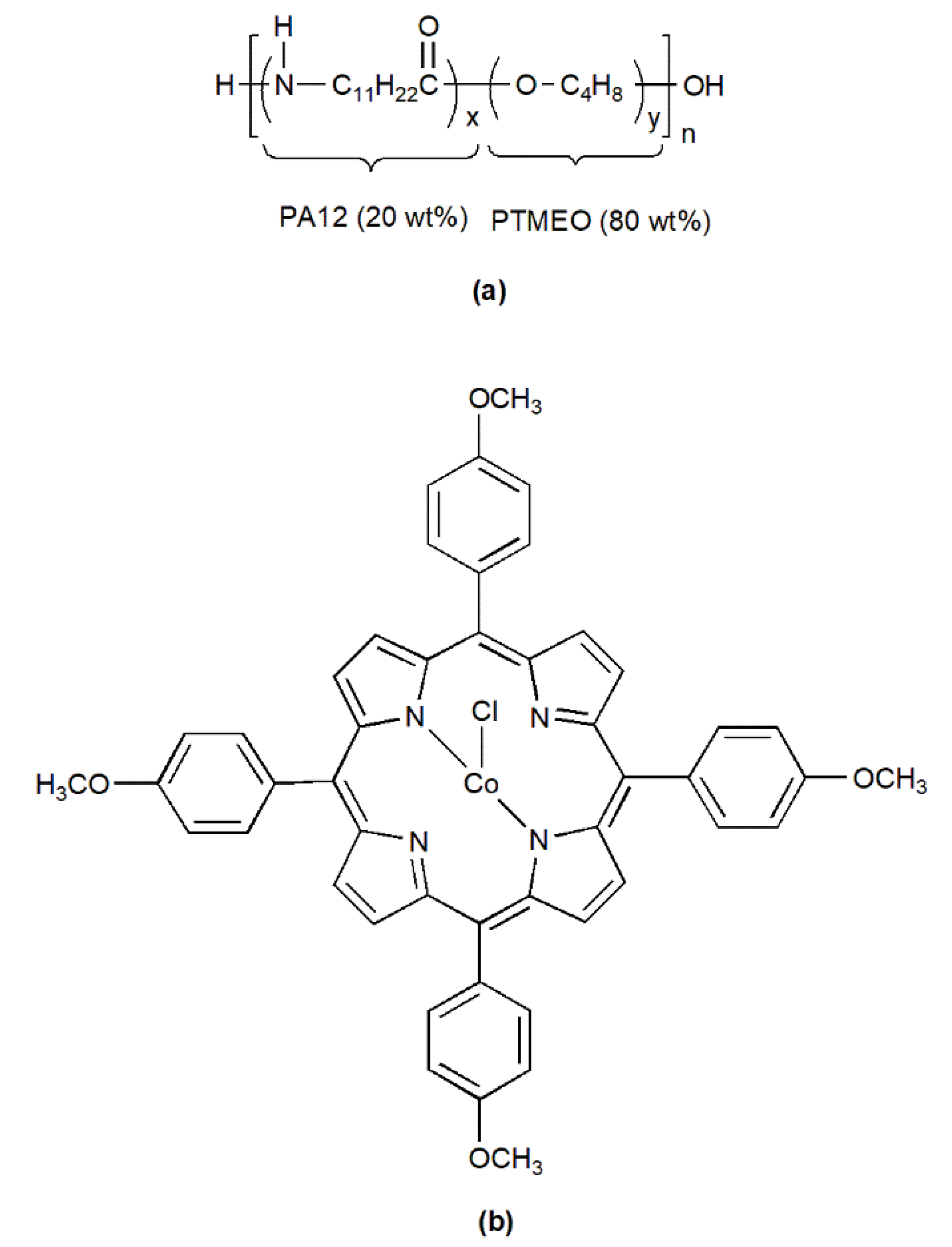
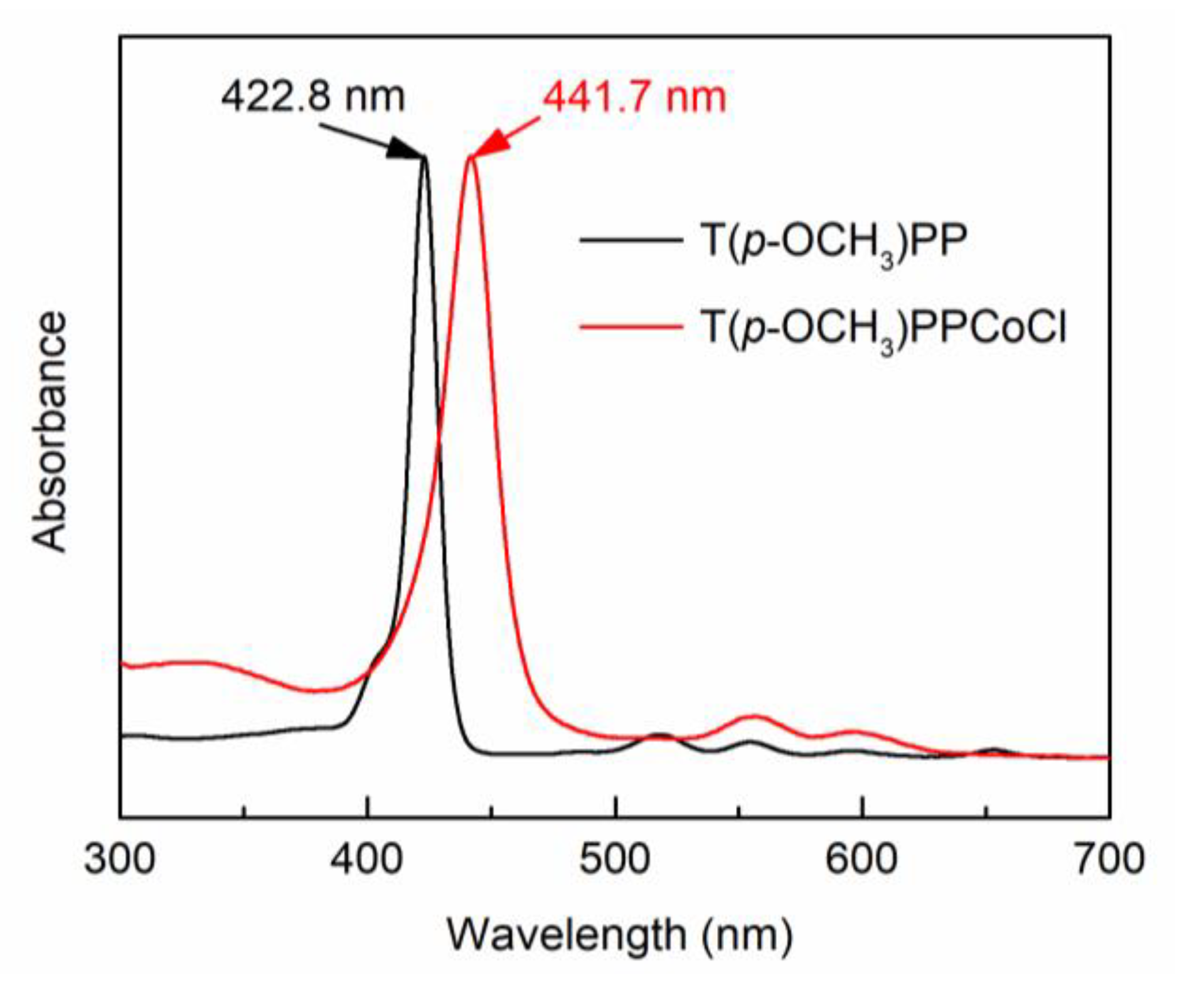

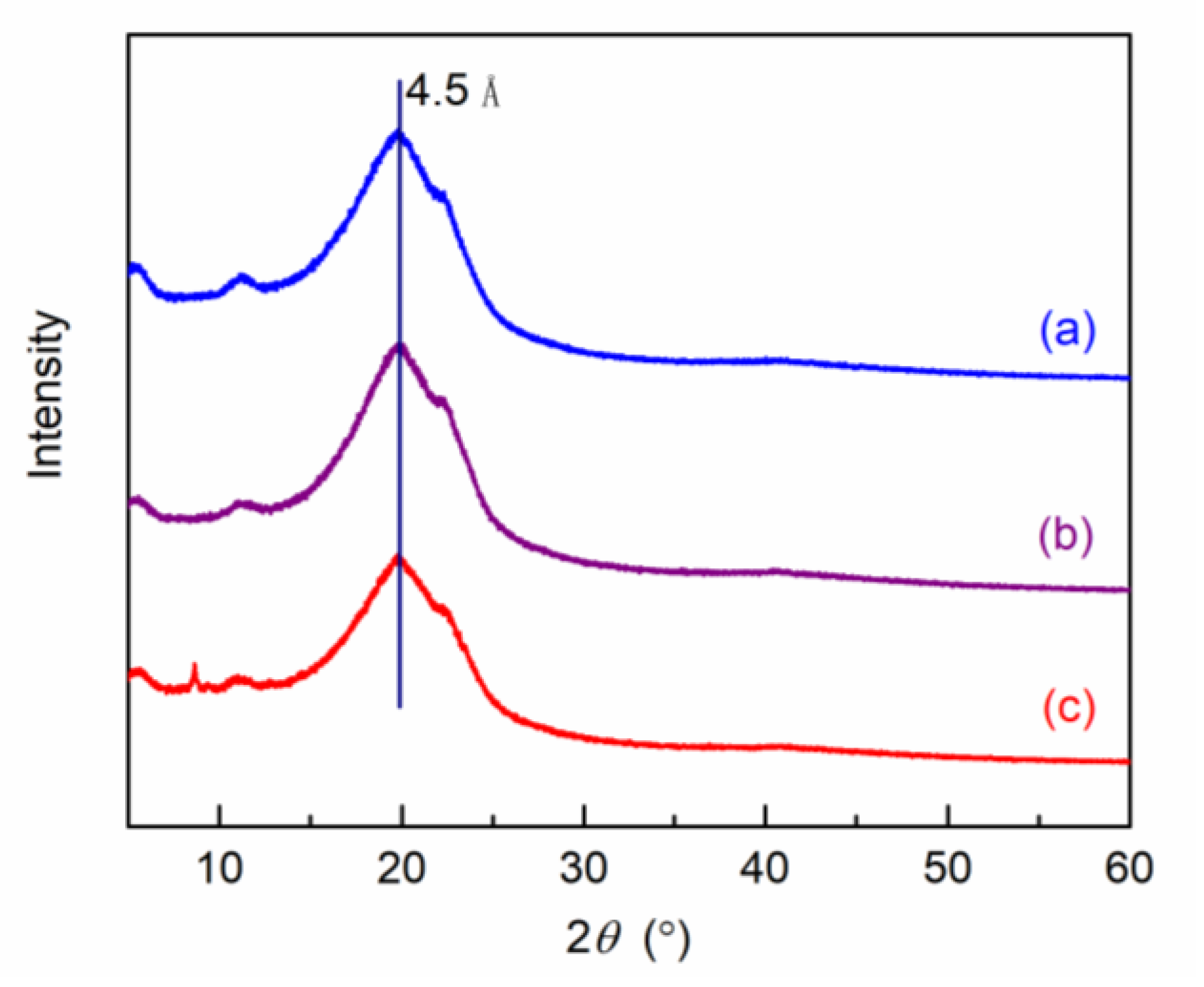
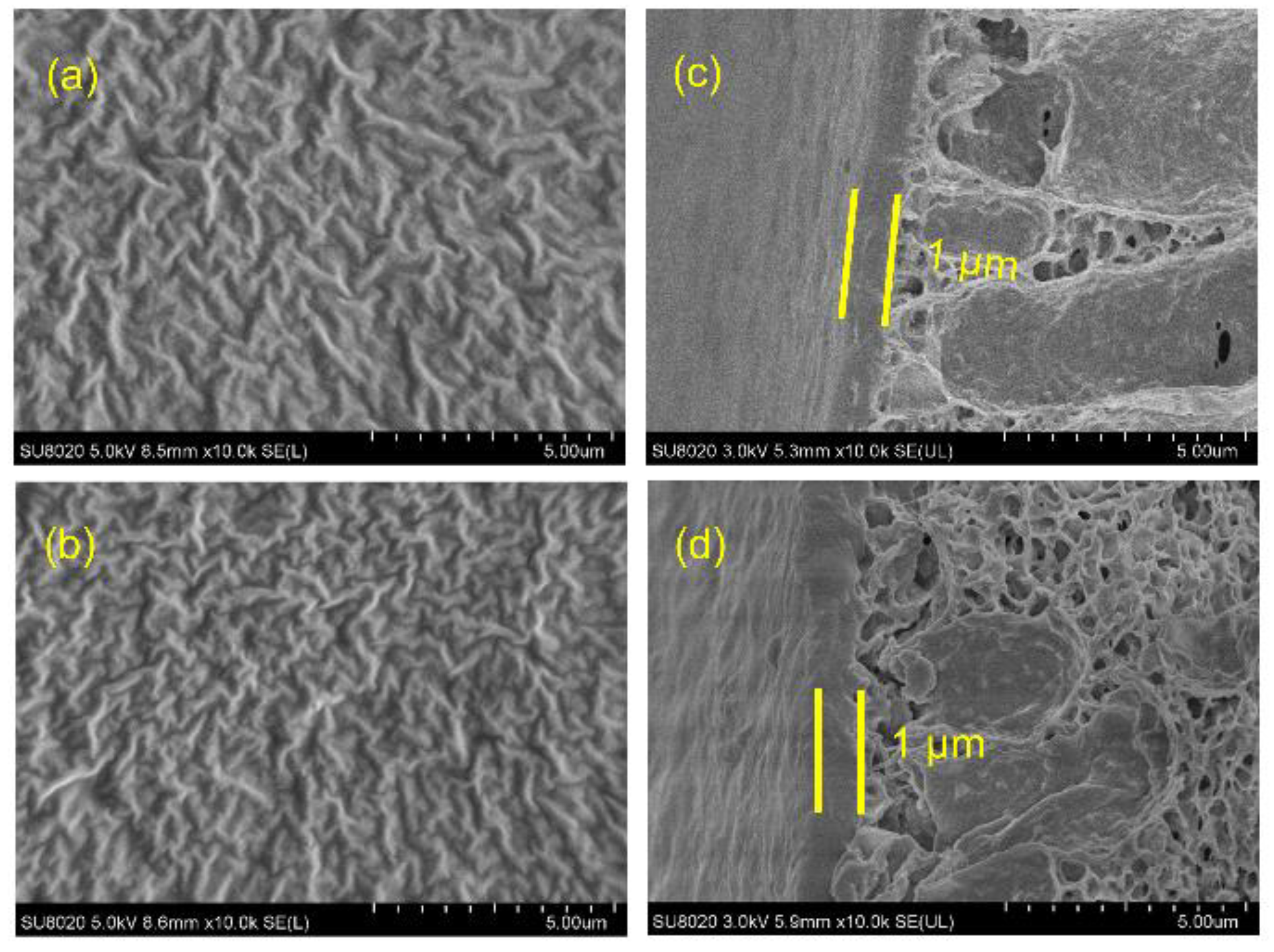

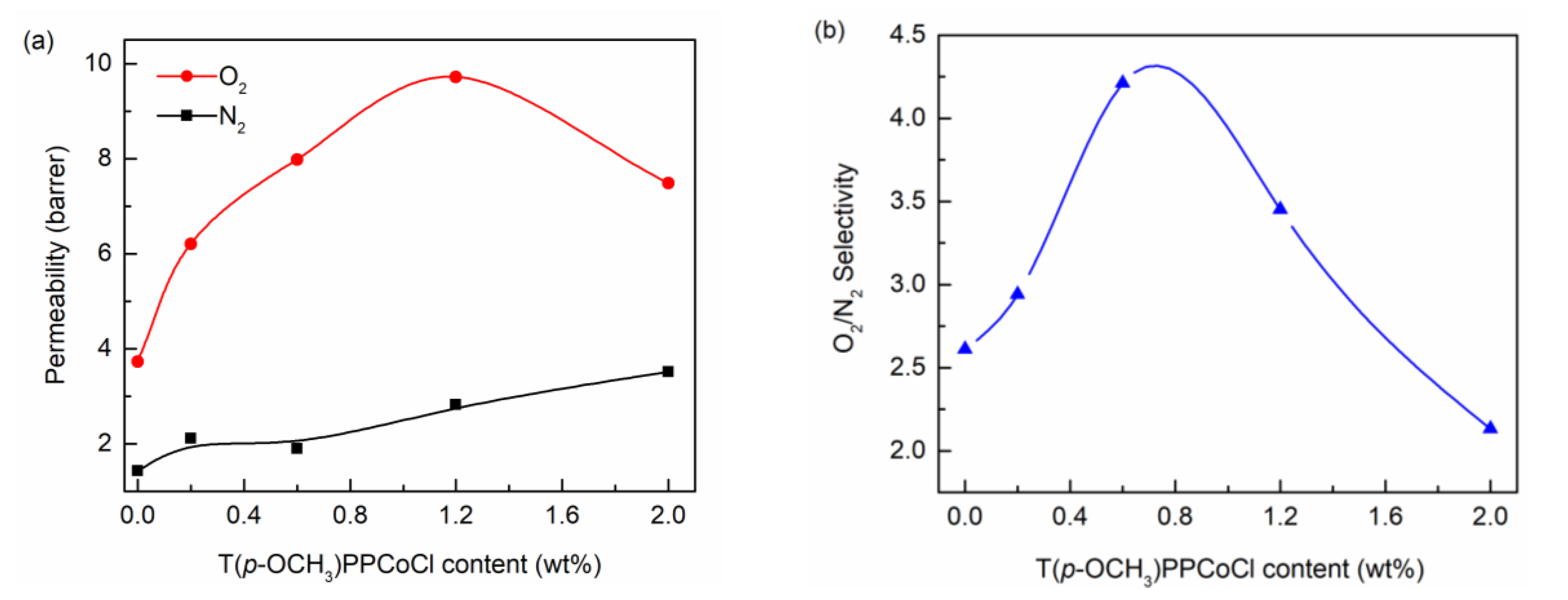
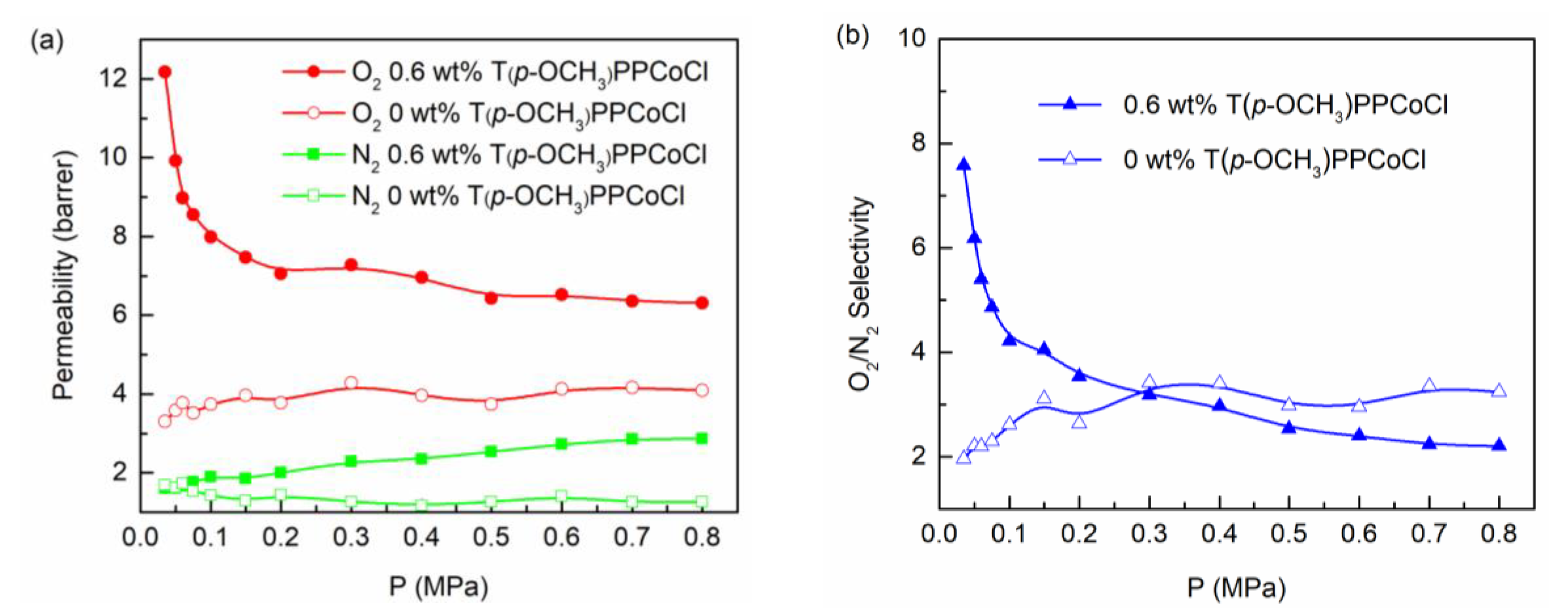
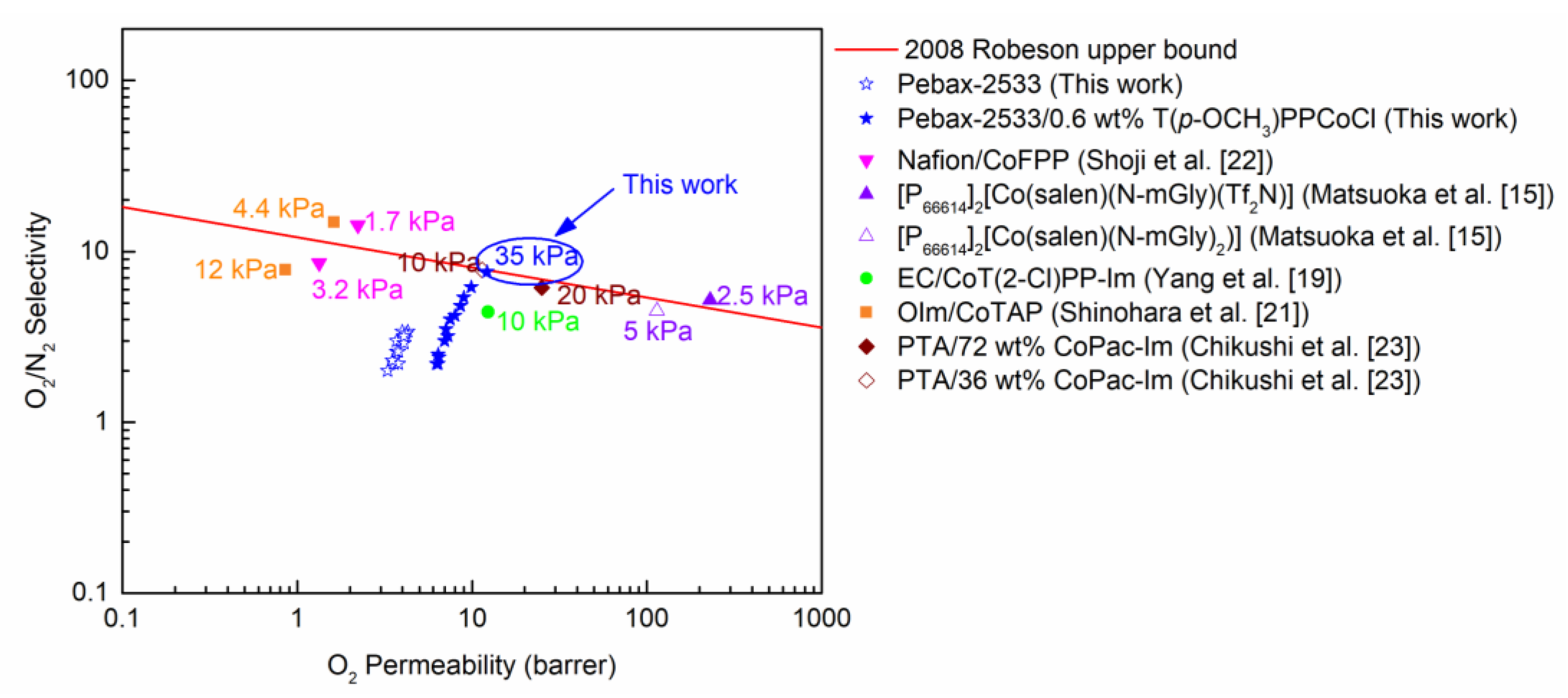
| Membrane | P (bar) | T (°C) | SO2/N2 | PO2 (barrer) a | Ref. |
|---|---|---|---|---|---|
| 1–15 wt % MgPc/PEI | 12.8 | 25 | ≈2.3–5.4 | ≈0.42–0.13 GPU b | [40] |
| 1–15 wt % CoPc/PEI | 12.8 | 25 | ≈4.8–1.9 | ≈0.25–1.13 GPU | [40] |
| 1 wt % cosalen/PU | 1 | 5–35 | ≈4.2–3.0 | ≈4.2–13.2 | [41] |
| 20 wt % CoFPP/Nafion | 1–2 | 25 | ≈14.2–2.0 | ≈2.2–0.3 | [22] |
| SiO2–PVP–salcomine | - | 25–150 | 1.4–6.1 | 0.35–1.48 GPU | [14] |
| 1 wt % CoPc/Pebax-1657 | 2–8 | 25 | ≈8.5–5.5 | ≈1.12–0.93 GPU | [13] |
| 0.6 wt % T(p-OCH3)PPCoCl/Pebax-2533 | 0.35–8 | 18 | 7.6–2.2 | 12.2–6.3 | This study |
© 2019 by the authors. Licensee MDPI, Basel, Switzerland. This article is an open access article distributed under the terms and conditions of the Creative Commons Attribution (CC BY) license (http://creativecommons.org/licenses/by/4.0/).
Share and Cite
Han, J.; Bai, L.; Yang, B.; Bai, Y.; Luo, S.; Zeng, S.; Gao, H.; Nie, Y.; Ji, X.; Zhang, S.; et al. Highly Selective Oxygen/Nitrogen Separation Membrane Engineered Using a Porphyrin-Based Oxygen Carrier. Membranes 2019, 9, 115. https://doi.org/10.3390/membranes9090115
Han J, Bai L, Yang B, Bai Y, Luo S, Zeng S, Gao H, Nie Y, Ji X, Zhang S, et al. Highly Selective Oxygen/Nitrogen Separation Membrane Engineered Using a Porphyrin-Based Oxygen Carrier. Membranes. 2019; 9(9):115. https://doi.org/10.3390/membranes9090115
Chicago/Turabian StyleHan, Jiuli, Lu Bai, Bingbing Yang, Yinge Bai, Shuangjiang Luo, Shaojuan Zeng, Hongshuai Gao, Yi Nie, Xiaoyan Ji, Suojiang Zhang, and et al. 2019. "Highly Selective Oxygen/Nitrogen Separation Membrane Engineered Using a Porphyrin-Based Oxygen Carrier" Membranes 9, no. 9: 115. https://doi.org/10.3390/membranes9090115
APA StyleHan, J., Bai, L., Yang, B., Bai, Y., Luo, S., Zeng, S., Gao, H., Nie, Y., Ji, X., Zhang, S., & Zhang, X. (2019). Highly Selective Oxygen/Nitrogen Separation Membrane Engineered Using a Porphyrin-Based Oxygen Carrier. Membranes, 9(9), 115. https://doi.org/10.3390/membranes9090115







